
The ornate chorus frog is a species of chorus frog endemic to the Southeastern United States. Their distribution ranges from North Carolina, east to the very eastern part of Louisiana, and south to northern parts of Florida.

The spring peeper is a small chorus frog widespread throughout the eastern United States and Canada. It prefers permanent ponds due to its advantage in avoiding predation; however, it is very adaptable with respect to the habitat it can live in. In northern regions, the frog is able to endure below freezing temperatures due to the capacity of its liver to exude and flush the bloodstream with a glucose cryoprotectant which acts both as an anti-freeze in its blood, and allows organs like the heart to enter into a state of protected dormancy. The peeper earned its name from its chirping call, which marks the beginning of spring. Crucifer is derived from the Latin root meaning "cross-bearing", a reference to the cross-like pattern on the spring peeper's dorsal side.
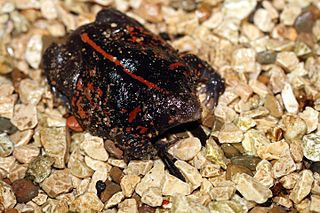
The Mexican burrowing toad is the single living representative of the family Rhinophrynidae. It is a unique species in its taxonomy and morphology, with special adaptations to assist them in digging burrows where they spend most of their time. These adaptations include a small pointed snout and face, keratinized structures and a lack of webbing on front limbs, and specialized tongue morphology to assist in feeding on ants and termites underground. The body is nearly equal in width and length. It is a dark brown to black color with a red-orange stripe on its back along with splotches of color on its body. The generic name Rhinophrynus means 'nose-toad', from rhino- (ῥῑνο-), the combining form of the Ancient Greek rhis and phrunē.

The Pacific tree frog, also known as the Pacific chorus frog, has a range spanning the Pacific Northwest, from Northern California, Oregon, and Washington to British Columbia in Canada and extreme southern Alaska. They live from sea level to more than 10,000 feet in many types of habitats, reproducing in aquatic settings. They occur in shades of greens or browns and can change colors over periods of hours and weeks.
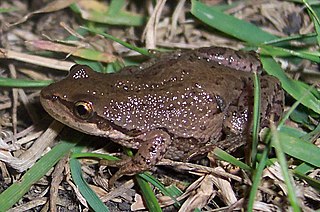
The boreal chorus frog is a species of chorus frog native to Canada from central Quebec to eastern British Columbia and north to the Northwest Territories and the southern portion of the Yukon. It occurs in the USA throughout Montana, northwestern Wisconsin, northeastern Arizona, northern New Mexico, and southwestern Utah.
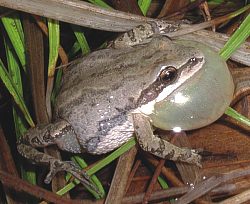
The western chorus frog, also known as striped chorus frog, or midland chorus frog is a species of frog found in Canada and the United States.

The little grass frog is a species of chorus frog endemic to the Southeastern United States. It is currently the smallest North American anuran and occurs in a wide variety of ephemeral and semi-permanent wetlands.

The northern red-legged frog is a species of amphibian whose range is the coastal region stretching from southwest British Columbia to southern Mendocino County in Northern California, and is protected in Oregon and California. As a member of the genus Rana, this species is considered a true frog, with characteristic smooth skin and a narrow waist. This frog requires still waters for breeding, and is rarely found at any great distance from its breeding ponds or marshes.

The oak toad is a species of toad in the family Bufonidae. It is endemic to the coastal regions of southeastern United States. It is regarded as the smallest species of toad in North America, with a length of 19 to 33 mm.
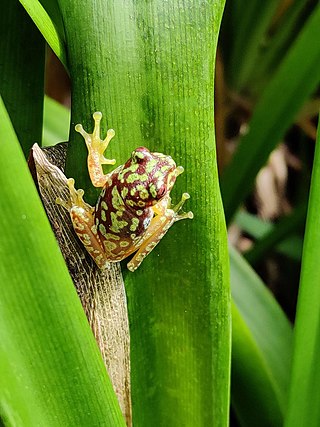
The Copan brook frog is a species of frog in the family Hylidae found in northeastern Guatemala and northwestern Honduras, specifically in the Sierra del Merendón, Sierra de Omoa, Sierra de Caral, and Sierra Espíritu Santo ranges. The colouring of this species is very distinctive and the specific name soralia comes from the resemblance of its markings to the vegetative structures on some crustose lichens.
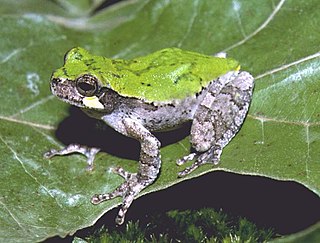
The bird-voiced tree frog is a species of frog in the family Hylidae, endemic to the United States. Its natural habitats are temperate forests, shrub-dominated wetlands, and swamps.
The Hispaniolan yellow tree frog, or common treefrog, is a species of frog in the family Hylidae endemic to Hispaniola, where it is found in both the Dominican Republic and Haiti.

The Appalachianmountain chorus frog, formerly known as just the mountain chorus frog, is a species of frog in the family Hylidae. The species is endemic to the United States. The natural habitats of P. brachyphona are temperate forests, rivers, intermittent rivers, swamps, freshwater marshes, intermittent freshwater marshes, freshwater springs, ponds, open excavations, and canals and ditches. It is threatened by habitat loss.

Brimley's chorus frog is a species of frog in the family Hylidae. It is endemic to the United States and is named for North Carolina zoologist C.S. Brimley.

The Natal banana frog also known as the Natal Leaf-folding Frog is a species of frog in the family Hyperoliidae. It is found in South Africa and possibly Lesotho. Its natural habitats are temperate forests, temperate shrubland, swamps, intermittent freshwater marshes, arable land, rural gardens, ponds, and canals and ditches. It is threatened by habitat loss.

The micro frog, or Cape Flats frog, is a species of frog less than 2 cm (0.8 in) long in the family Pyxicephalidae, in the monotypic genus Microbatrachella. Its color varies from rufous brown with dark mottling, to tan or green, depending on the population. It is endemic to the south-western Cape area of South Africa, with a single population found on the Cape Flats of Cape Town and several populations on the eastern side of False Bay. It typically lives in wetlands in coastal fynbos habitats, but its total area of occupancy is very small, and the International Union for Conservation of Nature has rated it as being "critically endangered".

Pseudacris fouquettei is a species of chorus frog found in the south-eastern United States. It was recently separated from similar species, Pseudacris feriarum.
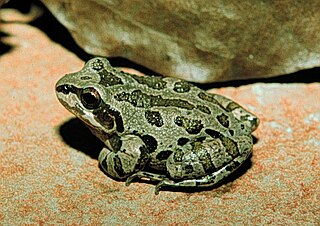
The Illinois chorus frog is a species of chorus frog that lives in scattered, restricted habitat ecosystems in the states of Arkansas, Illinois, and Missouri. It was published by Smith in 1951. Its life cycle is little known, its isolated populations are increasingly restricted by agricultural drainage, and it is listed as a threatened subspecies. It is often referred to as a subspecies of P. streckeri. Collins recognized it as its own species which was followed by ASW6.0 and Amphibiaweb on the basis of its diagnosability from Pseudacris streckeri and its allopatry. The IUCNredlist 2013.2 has not incorporated this taxonomic split.

Pseudacris kalmi, the New Jersey chorus frog, is a species of frog in the treefrog family Hylidae. It is found in the states near New Jersey in the United States. It was first described as subspecies of Pseudacris triseriata but it is differentiated by range and size. This frog's color ranges from grey to tan or greenish brown with a dark stripe on both sides of the body that extends from the snout, through their eyes, and to the groin. It breeds in early spring from February to April. It broods in shallow bodies of water, especially vernal pools, which dry up later in the season.
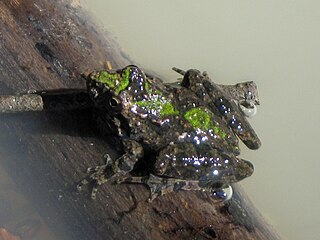
Acrisinae is a subfamily of the tree frog family Hylidae. There are only two genera in this subfamily, Acris and Pseudacris. They are native to most of the Nearctic realm, and are found as far north as the Great Slave Lake in Canada, all across the United States, and down Baja California and some parts of northern Mexico. One species, the pacific tree frog, has been introduced to several locations outside its range, and it is possible that other species may have been as well.





















